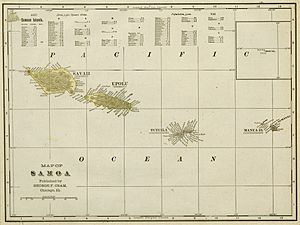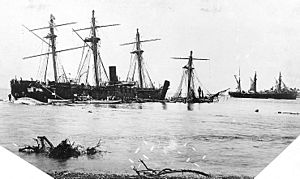History of Samoa facts for kids
The Samoan Islands were first settled about 3,500 years ago. This happened during a big movement of people called the Austronesian expansion. Samoa's history is closely linked to its neighbors, Tonga and Fiji. These islands have shared family ties and cultural traditions for a very long time.
European explorers first arrived in Samoa in the early 1700s. In 1768, Louis-Antoine de Bougainville called them the Navigator Islands. The United States Exploring Expedition reached Samoa in 1839. Later, in 1855, a German trading company expanded its business there.
Samoa faced civil wars in the late 1800s. These wars led to a struggle between powerful Western countries for control. The Tripartite Convention in 1899 divided the islands. The United States, Great Britain, and Germany split Samoa into German Samoa and American Samoa.
After World War I, New Zealand took over German Samoa. It was renamed the Western Samoa Trust Territory. This area became independent in 1962 and was called Samoa. American Samoa is still a territory of the United States.
Contents
Samoa's Ancient Past
It is believed that people first settled the Samoan archipelago around 2,900 to 3,500 years ago. This idea comes from finding ancient Lapita pottery pieces. The oldest pieces were found in Mulifanua and Sasoa'a, Falefa. The oldest signs of human life in Polynesia, Samoa, and Tonga are all from around the same time. This suggests that the first settlements happened across the region at once.
Not much is known about human activity between 750 BC and 1000 AD. This might have been a time when many people moved, leading to the settlement of today's Polynesia. Strangely, during this time, people seemed to stop making pottery. Samoan people do not have old stories that explain why this happened. Some experts think Polynesia lacked materials for making pottery. They believe most pottery used back then was brought in, not made locally.
Samoa's early history is connected to the chiefs of Fiji and the kingdom of Tonga. Samoan oral history tells of many battles between Samoa and nearby islands. Marriages between Tongan, Fijian, and Samoan royal families created strong bonds. These ties still exist today.
The main cultural traditions of Samoa are called the fa'asamoa. These traditions began with the warrior queen Nafanua. She created the fa'amatai system. This system involves decentralized family, village, and regional chief systems. Her niece, Salamasina, continued this system. Their time is seen as a golden age for Samoan culture.
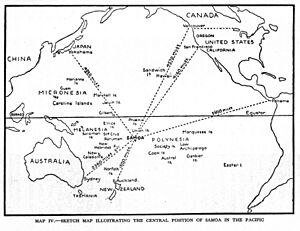
The Samoan language is part of the Polynesian language group. This group belongs to the larger Austronesian language family. Experts believe this family of languages started in Taiwan.
According to old stories, Samoa and Polynesia share a common ancestor named Tagaloa. The earliest history of Samoa focuses on a political center in the eastern islands of Manu'a. This area was ruled by the Tui Manu'a. In the Cook Islands, people believe that Karika, or Tui Manu'a 'Ali's, came from Manu'a. This suggests that other parts of Polynesia were settled from Manu'a and Samoa.
European Arrival and Influence
First European Contacts
Europeans started visiting Samoa in the early 1700s. However, their visits became more frequent when British missionaries arrived. In 1722, a Dutchman named Jacob Roggeveen was the first European to see the islands. Then, in 1768, the French explorer Louis-Antoine de Bougainville named them the Navigator Islands. In 1787, Jean-François de Galaup, comte de Lapérouse visited Samoa. There was a conflict on Tutuila Island, where twelve Frenchmen died.
Growing Western Presence in the 1800s
Missionaries and traders from Europe, Tahiti, and the Cook Islands began arriving around 1830. They were led by John Williams (missionary). The Rev. John Williams, with help from Ali'i Malietoa Vainu'upo, set up the London Missionary Society. This led to the creation of the Congregational Christian Church of Samoa.
The United States Exploring Expedition arrived in Samoa in 1839. They appointed an Englishman, John C. Williams, as a US commercial agent. A British consul was already living in Apia.
In 1855, a German trading company expanded its business into the Samoan Islands. During the late 1800s, German influence grew. Large plantations for coconut, cacao, and rubber were started. German companies controlled the processing of these goods. British businesses also had interests in Samoa, which gave Britain a reason to get involved. The United States Navy began using the harbor of Pago Pago in 1877. They formed alliances with local chiefs, especially on Tutuila and Aunu'u islands. On April 17, 1900, the US flag was raised in Fagatogo village. This made Eastern Samoa the US Territory of American Samoa. The Kingdom of Manu'a joined American Samoa in 1904.
By the 1880s, Great Britain, Germany, and the United States all claimed parts of Samoa. They set up trading posts. The competition between these powers made tensions worse among Samoan groups. These groups were all trying to gain full political control. The islands were divided among the three powers in the 1890s, and then between the United States and Germany in 1899.
The Samoan Civil Wars and Crisis
The First Samoan Civil War lasted from about 1886 to 1894. It was mainly fought between different Samoan groups. However, the powerful Western nations often got involved with their military forces. For eight years, each of the three powers gave weapons, training, and sometimes soldiers to the Samoan groups.
The Samoan crisis became very serious in March 1889. All three Western powers sent warships into Apia harbour. A big war seemed about to start. But a huge storm on March 15, 1889, damaged or destroyed the warships. This ended the military conflict.
Robert Louis Stevenson, a famous writer, arrived in Samoa in 1889. He built a house and quickly became interested in the local politics. Samoans asked him for advice, and he got involved in their affairs. He believed that the European officials ruling Samoa were not good at their jobs. After trying to fix things, he wrote a book called A Footnote to History. The book covered the years from 1882 to 1892. It was a strong protest against the situation. It led to two officials being removed from their posts.
The Second Samoan Civil War
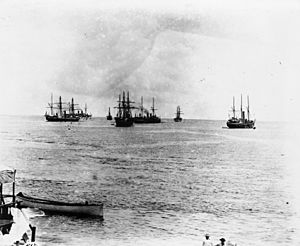
The Second Samoan Civil War became intense in 1898. Germany, Great Britain, and the United States argued over who should control the Samoan Islands.
The Battle of Apia happened in March 1899. Samoan forces loyal to Prince Tanu were surrounded by a larger group of Samoan rebels. These rebels were loyal to the powerful chief Mata'afa Iosefo. British and American warships sent landing parties to support Prince Tanu. After several days of fighting, the Samoan rebels were defeated.
American and British warships, including the USS Philadelphia, shelled Apia on March 15, 1899. After their initial defeat at Apia, Mata'afa's rebels defeated a combined American, British, and Tanu force at Vailele on April 1, 1899. The allies had to retreat. A reporter said that Mata'afa's warriors cut off the heads of American and British bodies left on the field.
Germany, Britain, and the United States quickly decided to end the fighting. They agreed to divide the islands at the Tripartite Convention of 1899. Because Tanu and his allies could not defeat Mata'afa in war, the Tripartite Convention promoted Mata'afa to Ali'i Si'i, the high chief of Samoa.
Dividing the Islands
The Samoa Tripartite Convention of 1899 was a meeting of three members. They were Bartlett Tripp for the United States, C. N. E. Eliot for Great Britain, and Freiherr Speck von Sternburg for Germany. They agreed to divide the islands.
The Convention gave Germany control of the islands west of 171 degrees west longitude. These included Upolu and Savaii (which is now the country of Samoa) and other nearby islands. These islands became known as German Samoa. The United States gained control of the eastern islands of Tutuila and Manu'a. These are now American Samoa. In return for Britain giving up its claims in Samoa, Germany gave Britain its protectorates in the North Solomon Islands and other areas in West Africa. It seems that no Samoans were asked about this division. The Samoan monarchy was also ended.
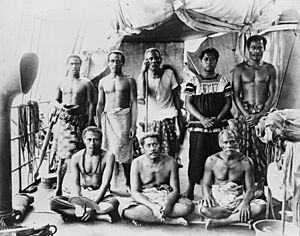

From 1908, Western Samoans began to demand their independence. This was through the Mau movement ("opinion movement"). The Mau movement started in 1908 with the 'Mau a Pule' resistance on Savai'i. It was led by the orator chief Lauaki Namulau'ulu Mamoe. Lauaki and other Mau a Pule chiefs, their wives, and children were sent away to Saipan in 1909. Many of them died while in exile.
World War I began in August 1914. Soon after, New Zealand sent a military force to take control of German Samoa. Germany did not officially give up the islands, but they offered no resistance. The occupation happened without any fighting. New Zealand continued to control Western Samoa throughout World War I. Under the Treaty of Versailles in 1919, Germany gave up its claims to the islands.
New Zealand's Administration
In November 1918, the Spanish flu hit the territory very hard. About 90% (34,471) of the 38,302 native people got sick. About 20% (6,894 people) died. The population of American Samoa was mostly saved from this disaster. This was due to the strong efforts of its governor, John Martin Poyer. Because of this, some Samoan citizens asked in January 1919 to be transferred to US control. The request was withdrawn a few days later.
New Zealand managed Western Samoa, or Samoa i Sisifo in the Samoan language. First, it was a League of Nations Mandate, and then a United Nations Trust Territory. The Mau movement grew stronger. Samoa's royal leaders became more active in supporting the movement, but they were against violence. On December 28, 1929, Tupua Tamasese was shot. Eleven others were also shot during a peaceful protest in Apia. Tupua Tamasese died the next day. His last words included a plea for no more bloodshed. The leaders of the Mau and other Samoans who criticized the administration were sent away to New Zealand. This included Olaf Frederick Nelson.
Samoa Becomes Independent
Samoa gained its independence from New Zealand on January 1, 1962. It adopted the name Western Samoa. Samoa's first prime minister after independence was the paramount chief Fiamē Mataʻafa Faumuina Mulinuʻu II. Later that year, a friendship treaty was signed with New Zealand. New Zealand agreed to help Western Samoa with foreign policy if needed. Samoa i Sisifo was the first Polynesian nation to be recognized as an independent country in the 20th century. Samoa became a member of the Commonwealth of Nations on August 28, 1970. In 1977, Queen Elizabeth II visited Samoa during her tour of the Commonwealth.
A small conflict happened between Samoa and American Samoa. This was after Samoa decided to remove the word "Western" from its name. The change was made by the Legislative Assembly of Western Samoa on July 4, 1997. This step caused "surprise and uproar" in nearby American Samoa. Some American Samoans felt the name change meant Samoa was claiming to be the "real" Samoa. They felt it implied American Samoa was just an American addition.
Two members of American Samoa's legislature went to Apia in September 1997. They met with Samoan Head of State Malietoa Tanumafili II. They tried to get the name change reversed to keep peace and good relations. An American Samoan request to the United Nations to ban Samoa from using the name Samoa was discussed seriously. Ten American Samoan representatives supported a bill to stop American Samoa from recognizing independent Samoa's new name. This bill did not pass. Independent Samoa's Prime Minister Tofilau Eti Alesana criticized the proposed American Samoan bill. He called it "rash and irresponsible."
In 2002, New Zealand's prime minister Helen Clark formally apologized for two events during New Zealand's rule. First, they failed to quarantine the ship SS Talune in 1918. This ship carried the 'Spanish 'flu' to Samoa. It led to an epidemic that greatly harmed the Samoan population. Second, she apologized for the shooting of leaders of the non-violent Mau movement during a peaceful march in 1929.
In 2007, Samoa's first head of state, His Highness Malietoa Tanumafili II, died at age 95. He held this title with Tupua Tamasese Lealofi until 1963. Malietoa Tanumafili II was Samoa's Head of State for 45 years. He was the son of Malietoa Tanumafili I, who was the last Samoan king recognized by Europe and the Western World.
Samoa's current head of state is His Highness Tuimalealiʻifano Vaʻaletoʻa Sualauvi II. He was chosen as head of state with the full support of Samoa's Parliament. This shows how important agreement is in traditional Samoan decision-making today.
In May 2021, Fiamē Naomi Mataʻafa became Samoa's first female prime minister. Her FAST party won the election by a small margin. This ended the long rule of Prime Minister Tuila'epa Sa'ilele Malielegaoi. On May 24, 2021, she was sworn in as the new prime minister.
In August 2022, Samoa’s Parliament chose Tuimaleali’ifano Vaaletoa Sualauvi II to be the Head of State for a second five-year term.
Samoa's Calendar Changes
When European traders began doing business in the Samoan Islands, they used their own date system. By the 1800s, Samoan calendars matched those of Asian countries to the west and south. However, in 1892, American traders convinced the king to change the country's dating system. This was to match the United States. So, the country lived through July 4, 1892, twice!
But 119 years later, Samoa's economy had changed. Most business was done with Australia and New Zealand. To switch back to the Asian date, Samoa and Tokelau skipped December 30, 2011.
See also
 In Spanish: Historia de Samoa para niños
In Spanish: Historia de Samoa para niños
- American Samoa
- History of Oceania
- List of prime ministers of Samoa
- Malietoa - a royal family and chief title
- Politics of Samoa


